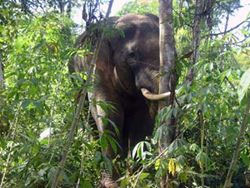VietNamNet Bridge – A 30km solar electric fencing system will be installed in southern Dong Nai Province's forest this year to minimize conflict between elephants from the Natural and Cultural Reserve and nearby villagers.
An elephant seen destroying cassava crops in Dong Nai Province. -- File Photo

"The fence system will be completely safe. It will enable the control of animals via sharp, but safe shocks, sufficiently memorable to prevent repeat offences," Mui said.
As many as 1,500 ‘danger' signs will be installed along the fence, which will include eight gates for forest rangers and people to pass through.
The province currently has more than ten elephants, including male, female and calves, living in an area of about 30,000ha of forest protected by reserve staff.
Nearby villagers often have their crops exposed to encroaching elephants, who not only cause destruction, but also a safety risk.
Dang Thi Yen Anh, a sugarcane farmer in Phu Ly Commune, Vinh Cuu District, said the elephants continuously destroyed his sugarcane, mango and cashew fields, as much as two ha out of a total ten.
Dang Van Nhon, head of Hamlet 2, said that many households had gathered at night to light lamps and knock pots together to deter elephants, who mostly seem oblivious to the threat they pose.
"The elephants trample cultivated ground in search of food. We believe the solar fence will sufficiently hinder their plans," Mui said.
In the last three years, the province spent nearly VND4 billion on compensation and support. Since 2009, nine elephants died in the reserve and the Tan Phu protective forest area, eight of them without a clear reason while one was shot.
Mui said the solar fence has been utilized in many countries, including India and Cambodia, with much success.
At present Viet Nam has between 75-130 elephants, mainly in the provinces of Dong Nai, central Nghe An Province and the Tay Nguyen (Central Highland) province of Dak Lak.
VietNamNet/Viet Nam News